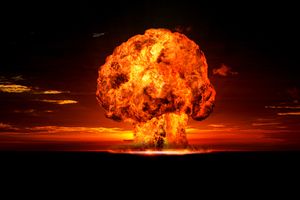A recent collaborative project between the Future of Life Institute and Nukemaps has created a visual representation of U.S. plans to use nuclear weapons against the Soviet bloc in 1959. The strikes, derived from a declassified list of U.S. nuclear targets published by the National Security Archive, reveals the big plans that the United States had for war in East Asia.
In the prosecution of nuclear war against the Soviet Union and its allies, the United States planned to launch numerous nuclear strikes against Chinese, North Korean, and Soviet territory. North Korea alone would suffer at least 11 strikes, with China and Soviet Pacific territory faring far worse. Targets included industrial centers, communication centers, transit hubs, and major military installations. Long range bombers would have delivered the bulk of the strikes.
It’s worth remembering that the U.S. military had engaged in extensive military conflict in East Asia in recent memory of 1959. U.S. troops had fought Chinese, Korean, and Japanese military forces in the region since 1944. This mean that the United States often had detailed knowledge of target sets in the region, with a good sense of how to maximize the destruction of Communist military, economic, and political targets.
One point worth noting is that the United States intended to liberally use nuclear weapons against territory still claimed by U.S. allies. On Taiwan, Chiang Kai Shek and the Republic of China still pretended to rule Mainland China, much of which would have been reduced to nuclear rubble by the U.S. strategic offensive. Similarly, Syngman Rhee’s Republic of Korea would have had some responsibility for cleaning up the mess that resulted from the nuclear devastation of North Korea. Notwithstanding Japanese claims of sovereignty over Sakhalin and the Kuril Islands, both would have received significant nuclear attention from U.S. bombers. South Sakhalin alone, at the time still inhabited by large Japanese and Korean minorities, would have suffered nearly a dozen strikes. Kunashir Island, sitting just a short distance from Hokkaido, earned two nuclear bombs.
The absences are also notable. Despite the establishment of a Communist regime in North Vietnam, Hanoi remains untouched. The left-leaning Sukarno regime in Indonesia also misses out on the fun. And undoubtedly in deference to the preferences of Her Majesty’s government, the United States would have avoided nuclear attacks in close proximity to Hong Kong (although the Guangzhou area would receive three strikes, and Huizhou one). Mongolia, for reasons unclear, escaped the notice of Strategic Air Command.
The target list concentrates on the expected strategic offensive against the Communist world. As the war developed, additional tactical weapons would have been used against the fielded forces of China, North Korea, and the Soviet Union, presumably causing even greater destruction. Had North Vietnam or some other country intervened on the Communist side, it likely would have found itself subject to the same kind of attack.

































